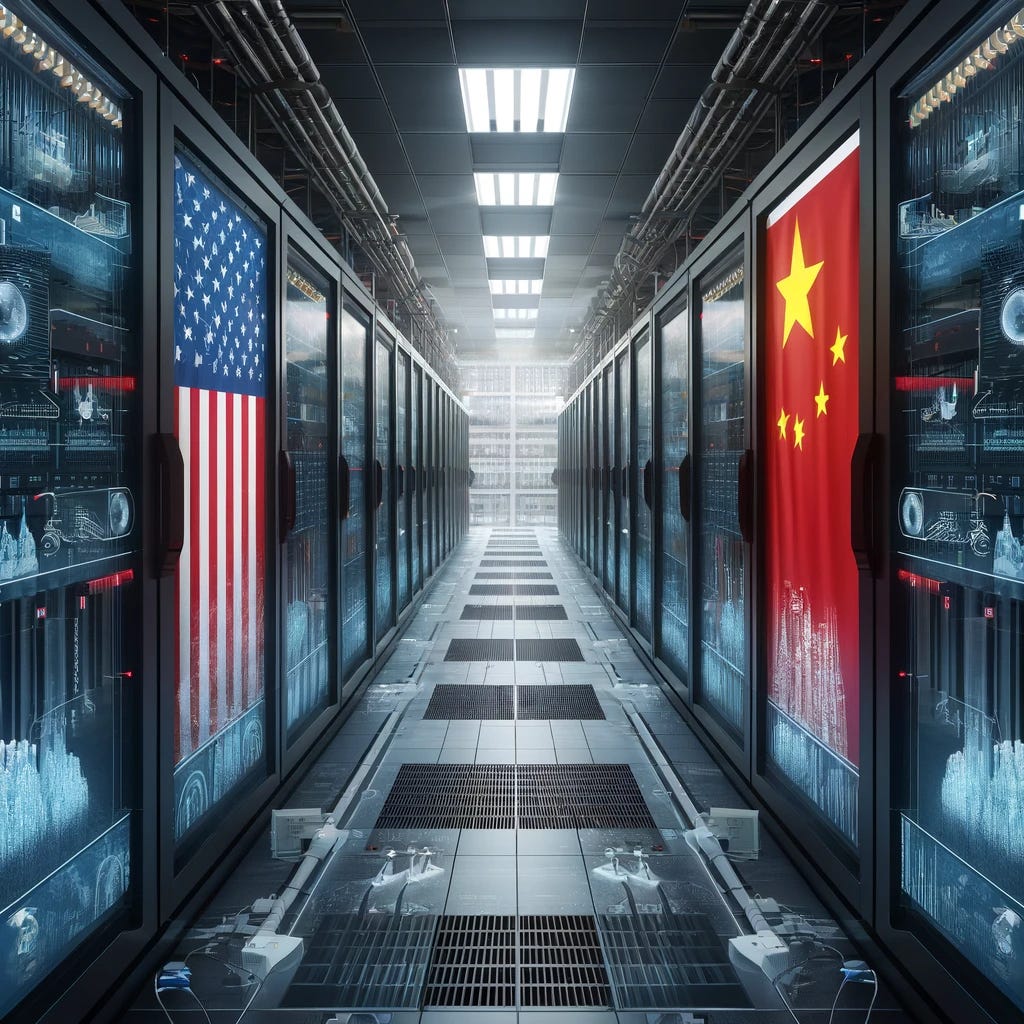Signal of Change: The Data Centre Battlefront
AI Arms Race Heats Up Between the US and China
The article “The Next Cold War is Taking Place in a Chilled Data Centre” published by the Australian Financial Review examines the escalating competition between the United States and China in artificial intelligence (AI). High-stakes talks in Geneva are focusing on AI safety and risk management. China is set to invest $1.55 trillion in AI over the next decade, while the US enacts legislative measures to curb AI technology transfer. Energy demands pose challenges, with China expanding its electricity supply as the US retires coal plants. AI's role in national security could reshape global power dynamics.
Signal of change Description
The US and China are intensifying their competition in the field of artificial intelligence, reminiscent of a new Cold War. This rivalry is characterized by substantial financial investments, strategic legislative actions, and national security implications. Both nations are striving to dominate AI technology, which is set to play a crucial role in future geopolitical and economic landscapes.
Signs of change
High-Level Diplomacy: Ongoing US-China talks in Geneva focused on AI safety and risk management.
Massive Investments: China's $1.55 trillion investment plan for AI over the next decade.
Legislative Actions: US legislative efforts to prevent the transfer of critical AI technologies to China.
Energy Infrastructure: China's expansion of its electricity supply to meet AI's energy demands, contrasted with the US's struggles due to retiring coal plants.
Strategic Significance: Increasing recognition of AI's importance in national security and its potential to alter global power dynamics.
Potential Implications
Technological Advancements: Both nations could see accelerated advancements in AI capabilities, potentially leading to breakthroughs in various sectors, including healthcare, finance, and defence.
Economic Shifts: The AI race may drive significant economic shifts, with the leading country gaining a substantial competitive edge in global markets.
Energy Consumption: AI's high energy demands could strain national grids, prompting innovations in energy efficiency and renewable energy sources. China’s expanded electricity supply might give it an advantage, while the US may need to find alternative solutions to meet its AI energy requirements.
Geopolitical Tensions: As AI becomes more integral to national security, geopolitical tensions between the US and China could escalate, leading to increased military and cyber conflicts.
Ethical and Safety Concerns: The rapid development of AI technologies may outpace regulatory frameworks, raising concerns about ethical use, safety, and potential misuse of AI in warfare and surveillance.
Global AI Standards: The competition may lead to divergent AI standards and practices globally, complicating international cooperation on AI governance and potentially creating fragmented technological ecosystems.
Innovation Ecosystem: The intense focus on AI could spur innovation ecosystems in both countries, fostering new startups and research initiatives but also possibly leading to talent drain and brain drain issues.
Long-Term Dominance: In 10 years, the nation that manages to integrate AI most effectively into its economy and defence systems could achieve long-term dominance in both technological and geopolitical arenas.
Timeline of Potential Escalation (2024-2034)
2024-2026: Initial Stages of Escalation
Diplomatic Negotiations: Continued high-stakes talks between the US and China focusing on establishing AI safety and risk management protocols.
Legislative Actions: The US intensifies legislative measures to restrict AI technology transfers to China, with more stringent export controls and collaboration bans.
Investment Surge: China’s AI investment begins to yield visible results, with advancements in AI research and commercial applications becoming evident.
Energy Initiatives: Both nations start implementing measures to address AI’s energy consumption. China expands renewable energy projects, while the US invests in next-gen energy technologies.
2027-2029: Mid-Stage Intensification
Technological Breakthroughs: Significant AI breakthroughs occur in both countries, impacting sectors like healthcare, finance, and defence.
Economic Impact: The economic divide widens, with the leading nation gaining substantial market dominance and technological leverage.
Military and Cyber Conflicts: Geopolitical tensions escalate, manifesting in increased cyber-attacks and AI-driven military standoffs.
Regulatory Efforts: Initial attempts at international AI regulation frameworks emerge, but face challenges due to differing national interests and technological standards.
2030-2032: Advanced Competition
AI Integration: Both nations achieve advanced integration of AI into critical infrastructure, defence systems, and public services.
Energy Strain: Energy demands for AI applications strain national grids, prompting accelerated efforts in energy innovation and efficiency.
Public and Ethical Concerns: Ethical dilemmas and public debates intensify over AI's role in society, privacy issues, and potential misuse in surveillance and warfare.
2033-2034: Peak Competition and Potential Resolution
Geopolitical Dominance: The leading AI nation leverages its technological advancements for geopolitical influence, potentially achieving a dominant position in global affairs.
Innovation Ecosystem Maturity: A mature innovation ecosystem supports continuous AI advancements, fostering economic growth and technological leadership.
International Cooperation: Potential establishment of robust international treaties and regulatory bodies to manage AI risks, promoting global cooperation and ethical standards.
Public Trust and Adaptation: Societal adaptation to AI technologies reaches a critical point, with increased public trust and integration of AI into everyday life.
The trajectory of this AI competition will have far-reaching implications, shaping not only the technological landscape but also the geopolitical, economic, and social fabric of the global community.


